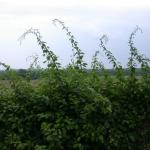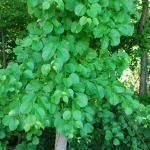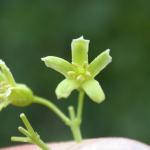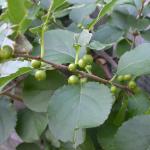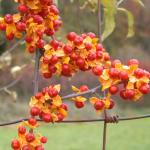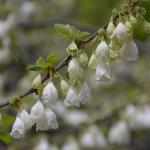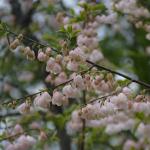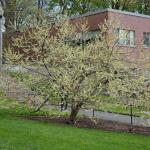A monthly e-newsletter from UMass Extension for landscapers, arborists, and other Green Industry professionals.
To read individual sections of the message, click on the section headings below to expand the content:
Hot Topics
TickTalk with TickReport! Webinar Series
A free live webinar series on the 2nd Wednesday of the month (March, April, May, and October) at noon.
Topics include: Ticks And Personal Protection; Deer Ticks (Ixodes scapularis) and Associated Diseases; 2018/2019 Tick Updates from the UMass Laboratory of Medical Zoology (LMZ); American Dog Ticks (Dermacentor variabilis) and Lonestar Ticks (Amblyomma americanum) and Associated Diseases; and 2019 Tick Updates From the UMass Laboratory of Medical Zoology (LMZ). More details at http://ag.umass.edu/landscape/education-events/webinars
edit
Questions & Answers
Q. Broadleaf evergreens like rhododendrons, hollies, Leucothoe and mountain laurels took a beating this winter, in spite of what seemed to be an overall mild season. Many leaves have bronzed or turned completely brown. In the case of Rhododendrons, whole sections of plants appear wilted and dying. What has happened and how should I treat these plants? Should I prune out affected parts?
A: It’s likely that a combination of factors contributed to the damage you’re seeing, some of which is also being seen on conifers. While the winter overall was generally mild, and we had limited snow accumulations, the mild periods were punctuated with cold, and we experienced many windy days. Additionally, excessive moisture in the previous growing season may have contributed to root loss in poorly drained soils. In the case of many of the broadleaf evergreens such as hollies, mountain laurel and Leucothoe, damaged leaves are most likely due to the extremely windy conditions, coupled with variable temperatures. Unseasonably low temperatures in early March, when the sun was strengthening and days were growing longer, warmed leaf tissue, which then lost moisture through transpiration at a time when soils were frozen and the moisture could not be replenished. Additionally, several days with winds of exceptional vigor (February 25th was notable for the particularly persistent wind with gusts between 40 and 60mph) contributing to moisture loss, again, when plants were unable to replenish. Looking even further back, November temperatures were colder than normal, while early January was unusually warm (58 degrees in Boston on January 1st). Snow cover, which serves as an insulator helping to moderate soil temperature, was notably absent in many regions, allowing for repeated freeze thaw cycles that can cause root injury in particularly shallow rooted plants like Kalmia, Rhododendron and Magnolia. Reports of the upper portions of plants showing browning and dead leaves, while lower and interior leaves remain unscathed, suggests that the injury on these plants is due to wind and cold temperatures and that those portions unaffected were protected by the limited snow cover or shielded by the remaining portions of the plant. In these cases, it’s quite possible that the damaged foliage will be lost but the wood and buds are still viable. Before pruning, check to see if stems are alive by scratching the bark with your thumbnail to see if the underlying wood is still green – if so, wait until late May or early June before pruning so that you can assess which parts remain alive. At that point, if portions fail to leaf out, prune back until you find living wood. Make a sloped pruning cut, ¼” above and sloping way from an outward facing shoot or bud.
If the wood and inner bark on damaged shoots are brown, examine the length of the stem to see if you find any breakage, signs of borers, or sunken, dark areas in the bark that might indicate of a pathogen like Botryosphaeria. The many species of Botryosphaeria affect a wide array of plants, including Rhododendron, Ilex, Acer, Malus, Prunus and Cornus. Damage can be seen throughout the year as foliage wilts and turns brown, or when branches fail to break dormancy in spring. The pathogen usually enters the vascular system through an injury or opening created by pruning, breakage, insect or deer damage, or other physical damage caused by weather or pests. It can remain in the plant, asymptomatic, until the plant is weakened by another stress. Signs of Botryosphaeria include sunken, dark-brown cankers along, and sometimes girdling, stems. The diseased wood is stained reddish-brown and, when cut in cross-section, may display a wedged-shaped darkened area. Tiny fungal fruiting structures dot the bark and spores are dispersed during wet periods, either by rain or overhead irrigation. Spores can also be transported by insects and pruning tools. Prune well below the damage, to an outward facing shoot or bud, or to the ground, and destroy any infected leaves and branches. Good fall or early winter cleanup around infected plants helps reduce subsequent infections, as spores overwinter in infected leaves and branches.
Rhododendron borer (Synanthedon rhododendri) damage often manifests itself during the growing season, but impacted shoots further stressed by winter conditions may show the effect this time of year. Look for the entry holes near the ground or in crotches of branches along the stem. When the borer is active in mid-late summer and again in early spring, frass and/or sawdust appear from the hole and may accumulate on the ground. Entrance and exit holes can be seen along the branches and can be pruned out and destroyed when larvae are in residence. The larvae pupate for two weeks in May with adult wasp-like clearwing moths emerging from late-May into early June. After mating, females restart the cycle by laying eggs near former tunnels, near pruning cuts, or in branch crotches. When the pupae emerge, they tunnel into the stem and begin feeding, and will overwinter in stems.
The sporadic dead branches visible throughout large and established rhododendrons may also be caused by root and crown rot from Phytophthora infection. Phytophthora is an organism that persists in poorly-drained, water-logged soils and proliferates when temperatures and moisture is high – just the conditions we experienced last summer and into the fall. It often gains a foothold when plants are planted too deeply, or in soils that are overly wet or compacted. Some plants experience stunted growth as Phytophthora spreads, followed by sudden branch die-back. Small areas of damage can be pruned out and, if excessive moisture is alleviated, the plant may survive. Heavily damaged plants are best removed as fungicides provide little relief from this organism. This disease persists in the soil, entering the root system and spreading upward, destroying the vascular system as it travels. Susceptible species, including Acer, Fagus, Ilex, Juniperus, Malus, Pieris, Prunus and Taxus should not be replanted where Phytophthora issues have been encountered. The damage to well-established plants that was seen this past winter may be the result of changing conditions – either locally around individual plants, or the broader changes to climate which have resulted in longer, wetter periods, extreme storms, and warmer than usual temperatures. These temperature and moisture shifts, combined with other environmental stresses, make it more important than ever to choose plants that are able to withstand a broad range of conditions. Those that are most sensitive to extremes are likely to be less successful in modern landscapes.
Joann Vieira, Director of Horticulture, The Trustees of Reservations
Trouble Maker of the Month
Invasive Oriental Bittersweet, Celastrus orbiculatus
Oriental bittersweet, Celastrus orbiculatus, is an invasive, deciduous vine found throughout New England. Native to Korea, China and Japan, it was introduced into the U.S. around 1860 as an ornamental vine.
This woody perennial reproduces sexually by seed and asexually by creeping roots that sprout to form new stems. Oriental bittersweet can be observed growing as a brushy groundcover to a height of a few feet or as a climbing vine on trees where the vines may reach 40 to 80 feet with a diameter of 3 to 4 inches. Trees and shrubs are often killed by the climbing vines. The stems of bittersweet are light or medium brown, with noticeable light horizontal marks; roots are bright orange. Alternate leaves are round with crenate margins, and the five-petaled, greenish-white flowers grow in clusters and are somewhat inconspicuous. These clusters are produced axillary (coming from the leaf axils) along the stem. Flowering occurs in late spring and early summer. Oriental Bittersweet is almost always dioecious, producing male (staminate) and female (pistillate) flowers on separate plants. This can readily be observed in the fall as the female plants will be laden with fruit while male plants are fruitless. Occasionally, plants can be polygamodioecious with bisexual and male flowers on some plants and bisexual and female flowers on others.
Individual fruits are about 1/3", globoid-ovoid in shape, and glabrous (smooth). At maturity, the outer husk of each fruit turns yellow and splits open into 3 parts to reveal a bright red, fleshy fruit that contains 1-2 seeds. Fruits are readily consumed by birds and other small animals. Consumption of the fruit by animals is known to aid in the spread of this invasive plant. Oriental bittersweet is rarely affected by insect pests and disease organisms, which allows populations to grow unchecked. Humans can play a role in the spread of this invasive when they decide to use it as an ornamental plant in landscaping or collect branches of the colorful fruits for ornamental purposes.
Very similar to Oriental bittersweet is our native American bittersweet (Celastrus scandens), which is not commonly found throughout New England. American bittersweet has oval or elliptical rather than rounded leaves. The flowers and fruit of the female plants occur as single clusters at the tips of the stems (terminal) rather than spread along the stems (axillary). In areas where both species occur, it is possible for hybrids to develop. Pollen of these rare hybrids are reported to have low viability.
Management
Physical/Mechanical: Oriental bittersweet is a prolific seed producer and seedlings or small plants are very common. As part of an ongoing management program, seedlings and small plants should be pulled by hand as they appear. After Oriental bittersweet is controlled with herbicides, physical removal should be used as part of an ongoing management program to prevent regrowth.
Herbicides: Foliar applications of glyphosate will not control Oriental bittersweet; these applications will only cause temporary yellowing and the plant will recover in a short period of time. Foliar applications of triclopyr are a better postemergence option. Glyphosate and triclopyr can both be used as a cut stem/cut stump treatment. Selection of foliar versus cut stem/cut stump treatments will be determined by the growth habit of the Oriental bittersweet. In other words, whether it is growing as a groundcover (low-growing brush) or a tree-climbing vine. Triclopyr can also be applied a basal bark treatment.
Randy Prostak, UMass Extension Weed Specialist
Plant of the Month
Halesia carolina (Halesia tetraptera), Carolina silverbell
Halesia carolina is a small deciduous tree growing 30-40’ tall with a spread of 20-35’. Native to North America, it is found mostly in the Piedmont and mountains of the Carolinas, Tennessee, Georgia and Alabama. Smaller populations can be found as far west as Oklahoma and as far north as Ohio. In its natural setting, Carolina silverbell is an understory tree found growing along streams and moist slopes. In the landscape, plants have a broad to rounded, irregular crown with low forming branches.
Its common name comes from the white, bell-shaped, pendulous flowers that appear in early to mid-May. The flowers are primarily white; however, several pink forms are available. Flowers form in small clusters of 2-5. To fully appreciate the flowers, trees should be placed in the landscape for close viewing such as along a walkway, or near a deck or patio. Flowers develop into four winged drupes that change from green to brown in fall. The foliage is dark green in summer, turns yellow-green to yellow in fall, and defoliates relatively early. The bark is gray with white streaks when young, becoming ridged and furrowed with age.
Carolina silverbell is a wonderful small tree for the landscape, but also is appropriate in a mixed shrub or woodland border. This underutilized tree deserves more attention and has great versatility. Trees prefers rich, moist, well drained acidic soils in part shade to full sun. Unlike many other species, Carolina silverbell will flower profusely even in part shade. Plants are hardy in USDA zones 4-8 and rarely have insect of disease problems.
Cultivars:
‘Arnold Pink’ – rose-pink flowers, introduced by Arnold Arboretum
‘Meehanii’ – rounded shrub form
‘Savannah River’ – precocious, heavy flowering selection
‘Rosea’ – pink flower form
Related species or sub species
Halesia diptera
Halesia monticola
Halesia parviflora
Russ Norton, Agriculture & Horticulture Extension Educator, Cape Cod Cooperative Extension
Upcoming Events
Landscape Pests and Problems Walkabout - Diseases and Weeds
May 10, 2019 - 4:00 to 6:00 pm
Location: Newton Cemetery
Get some hands-on experience scouting and identifying landscape diseases, insects, weeds, and abiotic problems. Join UMass Extension specialists for a walk through the landscape as they discuss and demonstrate how to put IPM practices to work effi ciently and examine some of the most common pest and cultural problems of woody ornamentals. Dress for walking; workshops held rain or shine. Bring a clipboard, pencil and hand lens if possible.
Join Randy Prostak, Extension Weed Specialist and Nick Brazee, Extension Plant Pathologist, for this walkabout. 2 pesticide contact hours for categories 36 and Applicators License available; Association credits: 2 ISA, 1/2 MCLP, 1/2 MCA, and 1 MCH.
Registration and Additional Information.
Other Upcoming Events:
- 5/10: Landscape Pests and Problems Walkabout - Diseases and Weeds
- 6/2: Creating Pollinator Forage in the Landscape
- 6/12: Ornamental Tree and Shrub ID and Insect Walk
- 6/19: Weed Walkabout
- 6/20: Plant Camp 1: The Basics
- 6/25: Landscape and Turf Weed Topics - You pick!
- 6/27: Plant Camp 2: New introductons
For more information and registration for any of these events, go to the UMass Extension Landscape, Nursery, and Urban Forestry Program Upcoming Events Page.
Additional Resources
For detailed reports on growing conditions and pest activity – Check out the Landscape Message
For commercial growers of greenhouse crops and flowers - Check out the New England Greenhouse Update website
For professional turf managers - Check out Turf Management Updates
For home gardeners and garden retailers - Check out home lawn and garden resources. UMass Extension also has a Twitter feed that provides timely, daily gardening tips, sunrise and sunset times to home gardeners, see https://twitter.com/UMassGardenClip
Diagnostic Services
A UMass Laboratory Diagnoses Landscape and Turf Problems - The UMass Extension Plant Diagnostic Lab is available to serve commercial landscape contractors, turf managers, arborists, nurseries and other green industry professionals. It provides woody plant and turf disease analysis, woody plant and turf insect identification, turfgrass identification, weed identification, and offers a report of pest management strategies that are research based, economically sound and environmentally appropriate for the situation. Accurate diagnosis for a turf or landscape problem can often eliminate or reduce the need for pesticide use. For sampling procedures, detailed submission instructions and a list of fees, see Plant Diagnostics Laboratory
Soil and Plant Nutrient Testing - The University of Massachusetts Soil and Plant Nutrient Testing Laboratory is located on the campus of The University of Massachusetts at Amherst. Testing services are available to all. The function of the Soil and Plant Nutrient Testing Laboratory is to provide test results and recommendations that lead to the wise and economical use of soils and soil amendments. For complete information, visit the UMass Soil and Plant Nutrient Testing Laboratory web site. Alternatively, call the lab at (413) 545-2311.
